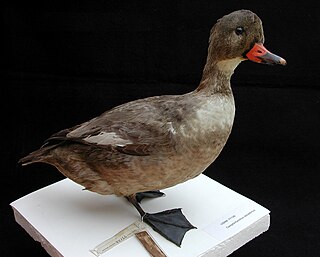
The Labrador duck is an extinct North American duck species. It has the distinction of being the first known endemic North American bird species to become extinct after the Columbian Exchange, with the last known sighting occurring in 1878 in Elmira, New York. It was already a rare duck before European settlers arrived, and as a result of its rarity, information on the Labrador duck is not abundant, although some, such as its habitat, characteristics, dietary habits and reasons behind its extinction, are known. There are 55 specimens of the Labrador duck preserved in museum collections worldwide.

The order Cephalaspidea, also known as the headshield slugs and bubble snails, is a major taxon of sea slugs and bubble snails, marine gastropod mollusks within the larger clade Euopisthobranchia. Bubble shells is another common name for these families of marine gastropods, some of which have thin bubble-like shells. This clade contains more than 600 species.

Bulla is a genus of medium to large hermaphrodite sea snails, shelled marine opisthobranch gastropod molluscs. These herbivorous snails are in the suborder Cephalaspidea, headshield slugs, and the order Opisthobranchia.

Haminoeidae, commonly known as the haminoeid bubble snail family, is a taxonomic family of sea snails, marine opisthobranch gastropod mollusks in the superfamily Haminoeoidea.

Atys is a genus of very small to medium-sized sea snails, marine opisthobranch gastropod mollusks in the family Haminoeidae.
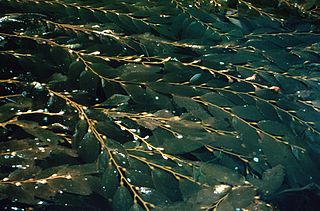
Macrocystis is a monospecific genus of kelp with all species now synonymous with Macrocystis pyrifera. It is commonly known as giant kelp or bladder kelp. This genus contains the largest of all the Phaeophyceae or brown algae. Macrocystis has pneumatocysts at the base of its blades. Sporophytes are perennial and the individual may live for up to three years; stipes/fronds within a whole individual undergo senescence, where each frond may persist for approximately 100 days. The genus is found widely in subtropical, temperate, and sub-Antarctic oceans of the Southern Hemisphere and in the northeast Pacific from Baja California to Sitka, Alaska. Macrocystis is often a major component of temperate kelp forests.

The Trochidae, common name top-snails or top-shells, are a family of various sized sea snails, marine gastropod molluscs in the subclass Vetigastropoda. This family is commonly known as the top-snails because in many species the shell resembles a toy spinning top.

Micromelo guamensis, common name the Guam paper bubble, is a species of sea snail, a bubble snail, a marine opisthobranch gastropod mollusk in the family Aplustridae.
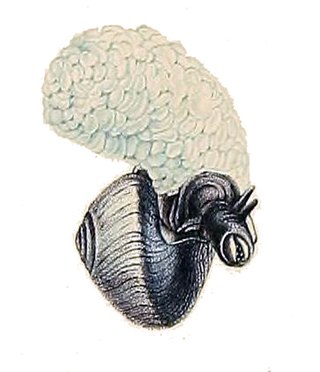
Janthina janthina is a species of holoplanktonic sea snail, a marine gastropod mollusk in the family Epitoniidae. Its common names include violet sea-snail, common violet snail, large violet snail and purple storm snail.

Bulla quoyii, the brown bubble snail, is a species of sea snail, a marine gastropod mollusc in the family Bullidae, the bubble snails.

The marine snail Norrisia norrisii is a medium-sized gastropod mollusk within the family Tegulidae. It has several common names, including Norris's top snail, Norris's topsnail, norrissnail, smooth brown turban snail, or kelp snail. It was first described by G.B. Sowerby I under the name Trochiscus norrisii. It is the only species in the genus Norrisia.
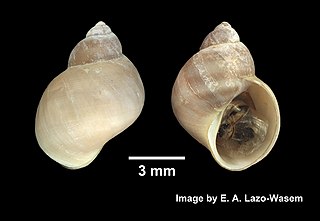
Lacuna vincta, commonly known as northern lacuna, wide lacuna, northern chink shell, or banded chink shell, is a species of sea snail, a marine gastropod mollusk in the family Littorinidae, the winkles or periwinkles. It is found intertidally and in shallow waters in both the northern Atlantic Ocean and the northern Pacific Ocean. It is a herbivore, feeding on seaweed and diatoms with its toothed radula.

Sphyraena argentea is a predatory species of marine barracuda fish of the family Sphyraenidae. They are found in the northeast Pacific Ocean, from Cabo San Lucas, Baja California Sur north to Washington State. However, they are not common north of Point Conception in Santa Barbara County, California, usually preferring warmer waters. They can reach a length of about 1.2 metres (3.9 ft) and a weight of about 6.8 kilograms (15 lb). This species of barracuda is a very popular sport fish in Southern California.

Nassarius fossatus, the channeled basket snail, is a species of sea snail, a marine gastropod mollusc in the family Nassariidae, the nassa mud snails or dog whelks. It is native to the west coast of North America where it is found on mudflats on the foreshore and on sand and mud in shallow water.
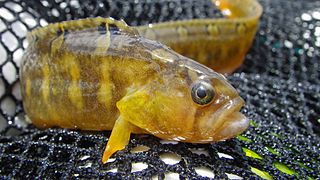
The crescent gunnel, also known as the bracketed blenny, is a species of marine ray-finned fish belonging to the family Pholidae, the gunnels. This fish occurs in the shallow coastal waters of the eastern North Pacific Ocean.

Bulla striata, commonly known as the common Atlantic bubble or striate bubble, is a species of sea snail, a marine gastropod mollusc in the family Bullidae, the bubble snails.
Acropora kirstyae is a species of acroporid coral that was first described by Jen Veron and C. C. Wallace in 1984. Found in marine, tropical, shallow reefs in sheltered areas usually at depths of 10 to 25 m, and also occurs in sheltered lagoons. It is listed as a vulnerable species on the IUCN Red List, and it is thought to have a decreasing population. It is not common and found over a large area, and is listed on CITES Appendix II.

The Pacific spiny lumpsucker is a species of bony fish in the family Cyclopteridae.
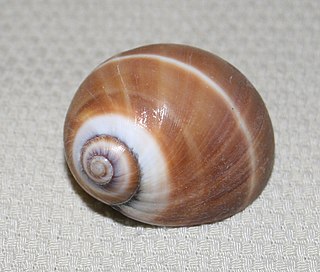
Polinices bifasciatus, or two-banded moon snail, is a species of gastropod mollusc. The animal was first described to science in a work authored by English biologists Edward Griffith and Edward Pidgeon. This was a multi-volume translation of George Cuvier's, Le Règne Animal (1830). The Griffith and Pidgeon work went beyond translation and added a supplement that included the description of Polinices bifasciatus. The description of Polinices bifasciatus is attributed to John Edward Gray. It reads, in its entirety, "Pale brown, with two narrow bands".

Bulla occidentalis is a species of mollusc in the genus Bulla.


















